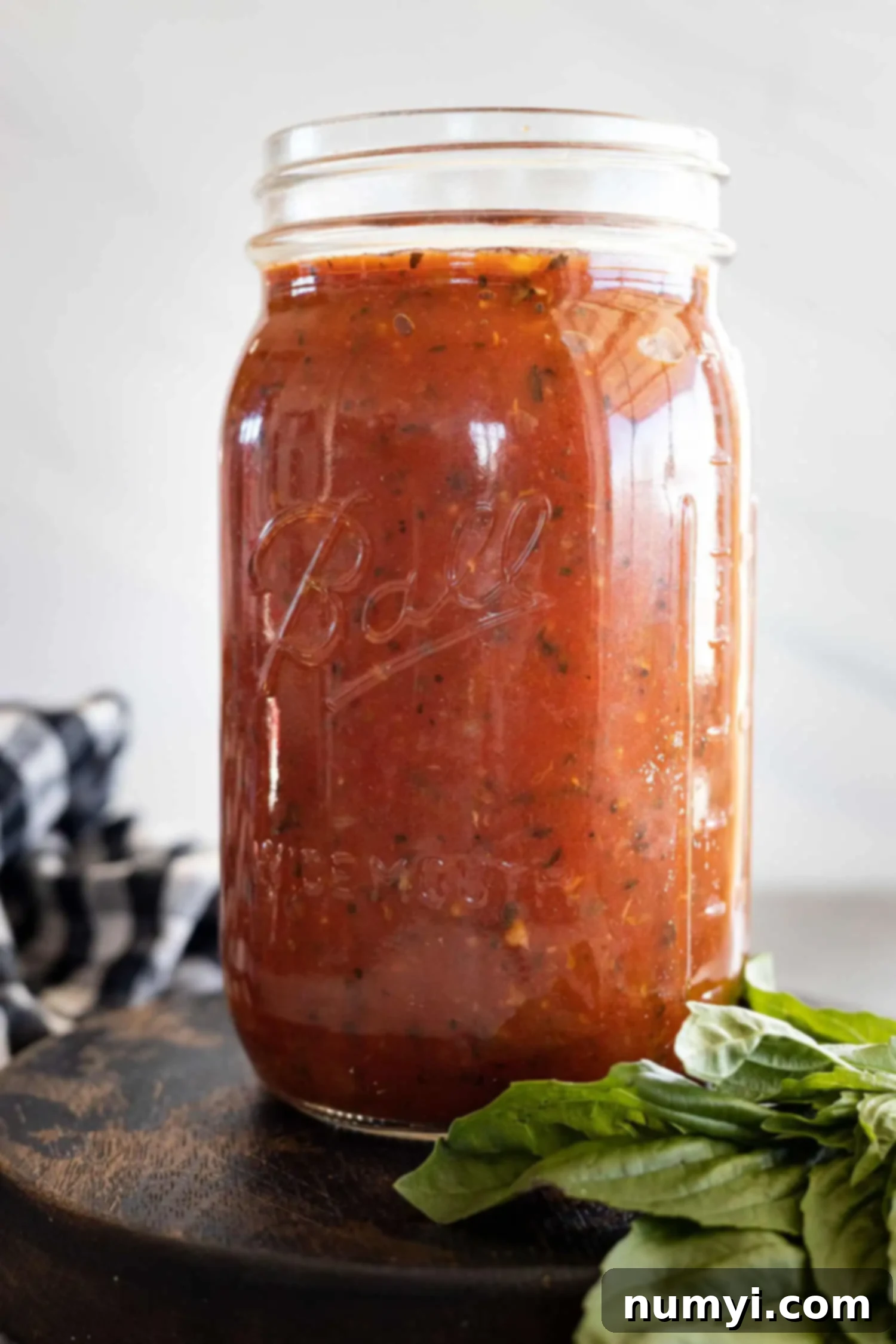Easy Homemade Marinara Sauce: Your Guide to the Freshest, Most Flavorful Italian Classic
There’s nothing quite like the rich aroma and vibrant taste of a truly authentic marinara sauce simmering on your stove. Forget bland, store-bought jars filled with preservatives and hidden sugars. This recipe for homemade marinara sauce is not just incredibly easy to make, it’s also a gateway to healthier, more flavorful meals. With a handful of staple ingredients and a little patience, you can create a wholesome, robust sauce that will elevate any Italian dish.
Whether you’re a seasoned chef or a kitchen novice, making your own spaghetti sauce is a culinary experience worth undertaking. It’s a fantastic way to take control of your diet, knowing exactly what goes into your family’s meals, free from artificial additives. Plus, the versatility of this sauce is unmatched – it’s perfect for a classic pasta night, a hearty chicken parmesan, or even as a gourmet dip for your favorite cheese breadsticks. Get ready to transform your cooking with this simple yet sensational marinara!
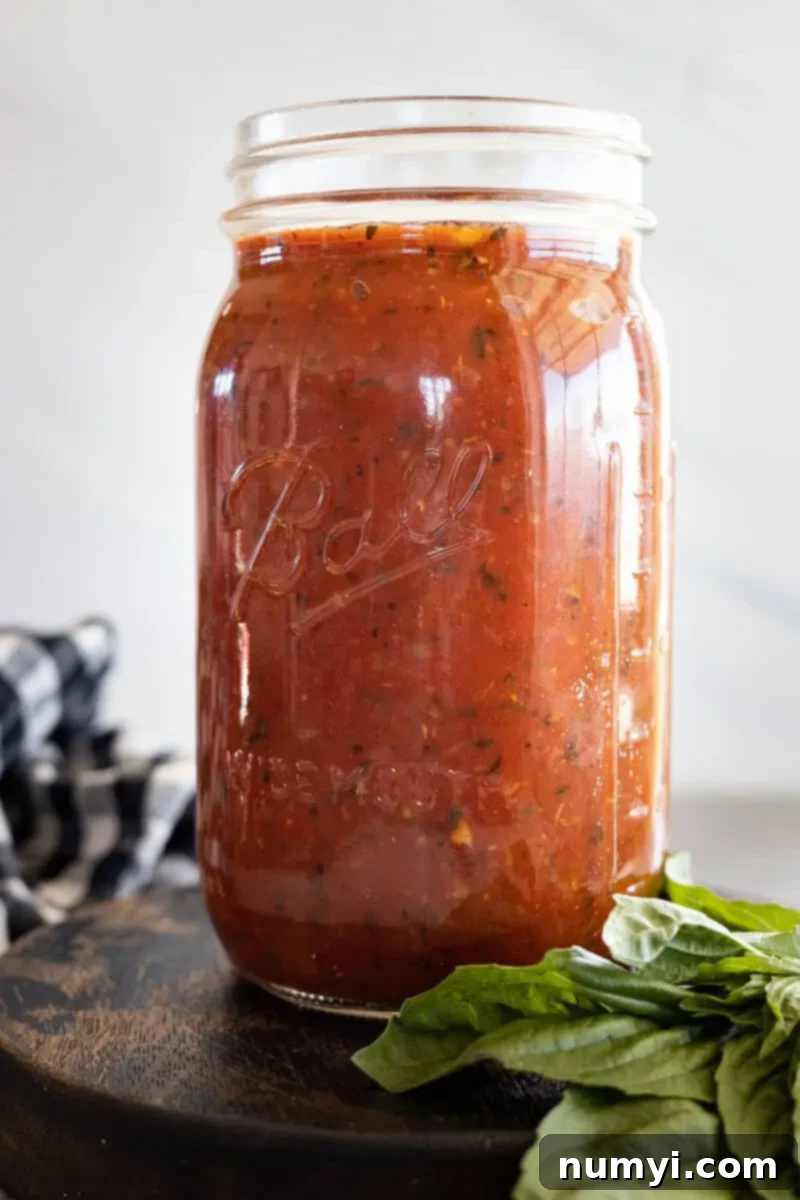
Why You Should Make Your Own Homemade Marinara Sauce
Ditching the store-bought jars for a homemade alternative offers a multitude of benefits that extend beyond just taste. Here’s why making your own marinara sauce is a game-changer:
- Budget Friendly: Quality store-bought marinara can be surprisingly expensive. By making your own from scratch, especially when buying canned tomatoes in bulk or on sale, you can significantly reduce your grocery bill. You’re paying for raw ingredients, not processing, packaging, and brand markup.
- You Control Everything in Your Sauce: This is perhaps the biggest advantage. Commercial sauces often contain high levels of sugar, sodium, and sometimes even artificial flavors or colors. When you make marinara at home, you dictate the quality of each ingredient. You can adjust salt levels to your preference, omit added sugars (which are often unnecessary), and choose organic ingredients if desired, ensuring a truly healthy and natural product.
- SUPER Easy to Make: Don’t let the idea of making sauce from scratch intimidate you. Marinara is one of the simplest sauces to master. It primarily involves sautéing aromatics and simmering tomatoes. The active cooking time is minimal, leaving most of the work to the stove.
- Freezer Friendly: This recipe is perfect for batch cooking. Make a double or triple batch and freeze portions for quick weeknight meals. Having homemade marinara on hand means you’re always just minutes away from a delicious, healthy dinner, saving you time and stress during busy periods.
- Canning Friendly: For those interested in food preservation, this marinara recipe is an excellent candidate for canning. With proper canning techniques, you can enjoy the fresh taste of summer tomatoes all year long, providing a pantry full of wholesome, ready-to-use sauce. (Note: Always follow specific canning guidelines for safety).
- Uses Easy-to-Find Everyday Ingredients: You won’t need any obscure or specialty ingredients for this marinara. All components – canned tomatoes, onion, garlic, olive oil, dried oregano, and fresh basil – are readily available at any grocery store, making this recipe accessible to everyone.
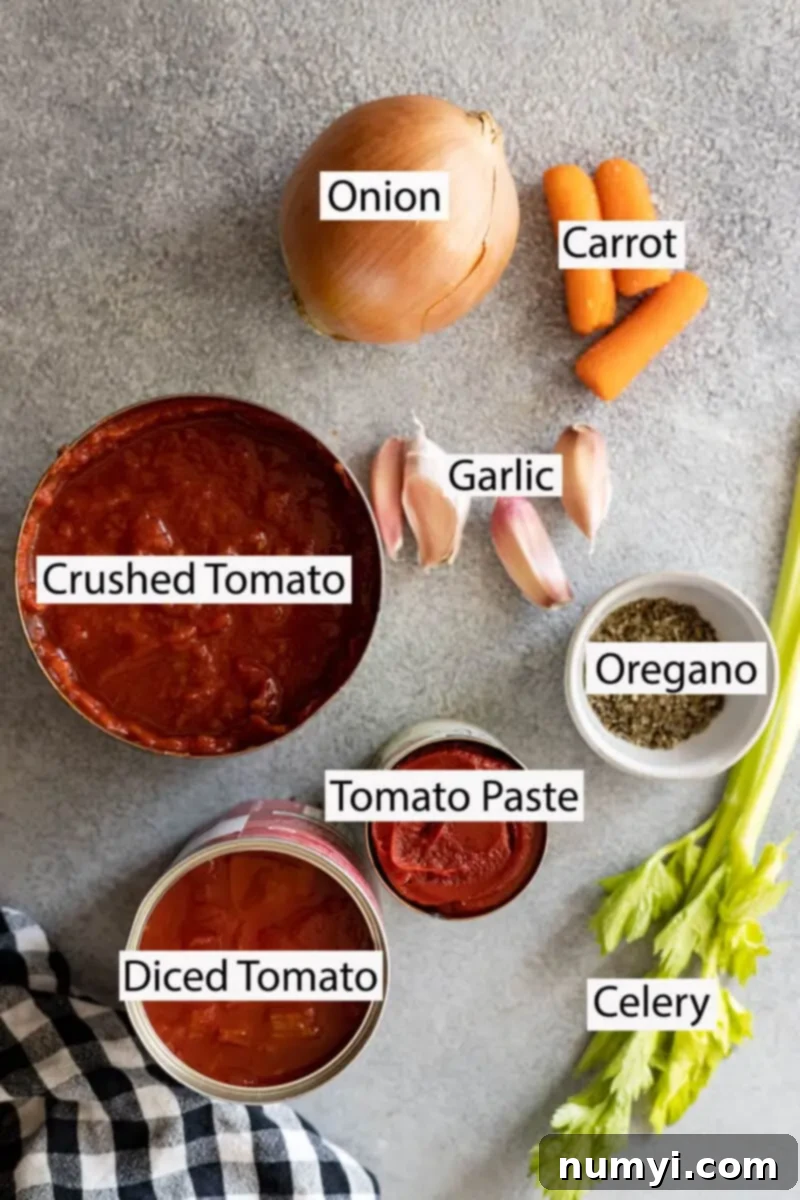
Essential Ingredients for a Perfect Marinara
The beauty of marinara lies in its simplicity. A few high-quality ingredients are all you need to create a truly spectacular sauce. Here’s a closer look at the key players:
Canned Tomatoes: The Heart of Your Sauce
Since tomatoes are the star of marinara, choosing good quality canned tomatoes is paramount. They form the foundation of your sauce, so their flavor will largely determine the final outcome.
- San Marzano Tomatoes: Often considered the gold standard for Italian sauces, San Marzano tomatoes are a fantastic choice. Grown in the volcanic soil of Italy, they are known for their sweet, balanced flavor and lower acidity, making for a naturally delicious sauce without the need for added sugar. Look for D.O.P. certified labels for true authenticity.
- A Blend for Depth and Texture: For a marinara that boasts both a smooth consistency and a pleasant texture, I recommend a combination:
- Crushed Tomatoes: These provide the smooth, consistent base for your sauce.
- Diced Tomatoes: Added for a little texture, giving your marinara a more rustic and homemade feel.
- Tomato Paste: This concentrated tomato product is essential for adding a deep, rich, umami flavor. Sautéing it briefly before adding other liquids caramelizes its sugars and intensifies its taste.
- Alternatives: If San Marzano are hard to find or out of budget, opt for other high-quality whole peeled tomatoes. You can crush them by hand for a similar effect, which often results in a fresher taste than pre-crushed varieties.
Onion and Garlic: The Aromatic Foundation
These two aromatics are the backbone of any great Italian sauce, providing layers of foundational flavor. Don’t be shy with them!
- Onion: A small onion, finely chopped, creates a savory base. Yellow or white onions work well. When sautéed until translucent, they release their natural sweetness and fragrance.
- Garlic: Four large cloves might seem like a lot, but garlic is crucial for marinara’s signature pungency and warmth. Feel free to add even more if you’re a garlic lover – it only enhances the sauce’s robust character.
Olive Oil: The Unsung Hero
Extra virgin olive oil is not just a cooking fat; it’s an ingredient that contributes significantly to the sauce’s flavor and luxurious mouthfeel. It’s used to gently sauté the aromatics, coaxing out their flavors, and adds a subtle fruitiness to the finished sauce.
Oregano and Basil: The Classic Italian Herbs
These two herbs are indispensable for authentic marinara flavor.
- Fresh Basil: A large sprig of fresh basil is vital. Basil’s natural sweetness helps to cut through the acidity of the tomatoes, often eliminating the need for any added sugar. Adding a whole sprig allows its flavor to infuse the sauce during simmering, and fresh leaves can be added at the end for brightness.
- Dried Oregano: Dried oregano offers a more robust, earthy flavor that stands up well to simmering. It complements the basil beautifully, providing that classic Italian herb profile.
Optional Veggies: Carrots and Celery for Extra Nutrition and Sweetness
While not traditionally found in classic marinara, I like to go a step further and add a small carrot and celery stalk. These vegetables provide a subtle sweetness and extra nutritional boost, without overpowering the core tomato flavor. They blend seamlessly into the sauce, making it an excellent way to sneak in some extra goodness, especially for picky eaters. This addition is entirely optional, so feel free to omit them for a purist marinara.

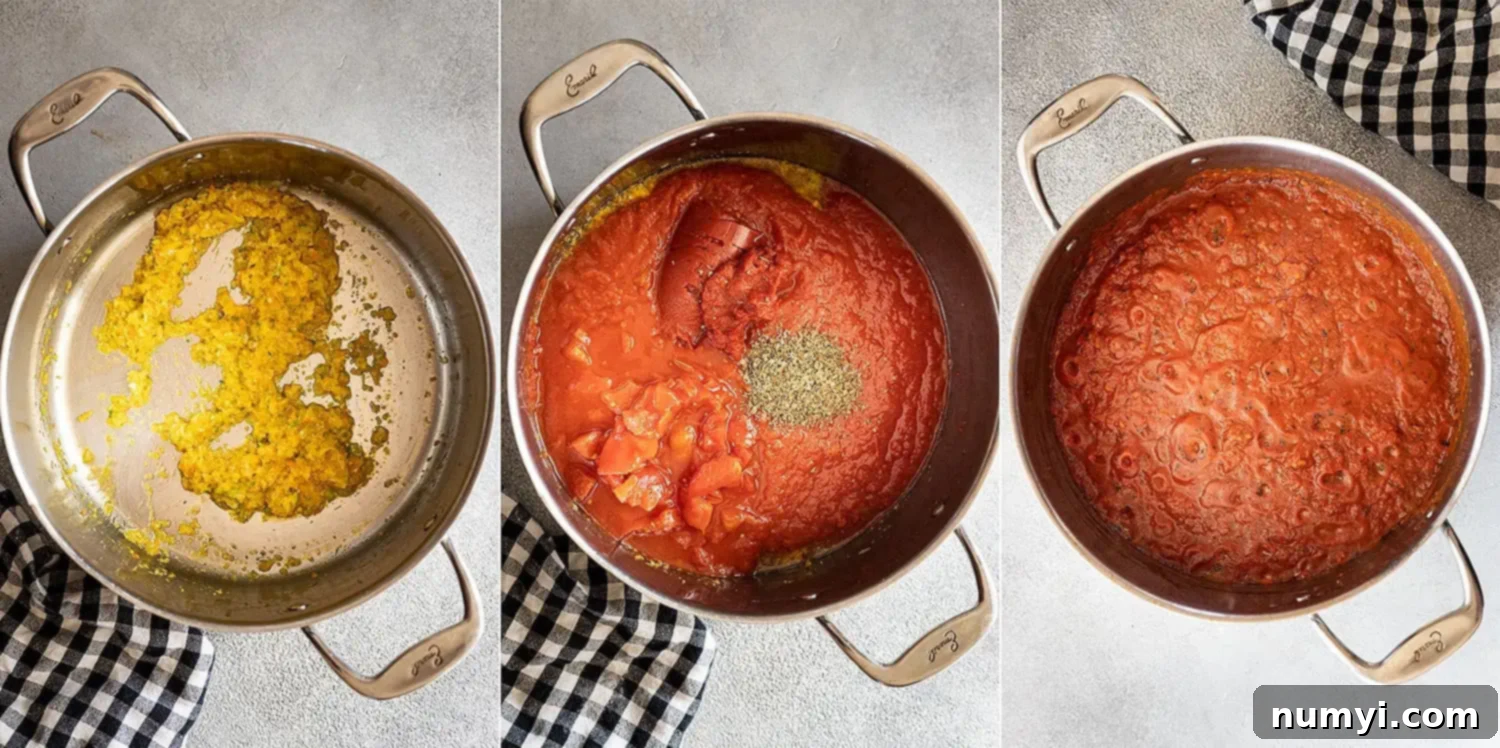
How to Make an Easy Homemade Marinara Sauce: Step-by-Step
Creating this flavorful marinara sauce is straightforward, requiring minimal effort for maximum reward. Follow these simple steps to bring a taste of Italy into your kitchen:
- Prepare Your Vegetables: Begin by finely chopping your onion, garlic, and the optional carrot and celery. Achieving a fine chop ensures that the vegetables melt into the sauce, contributing flavor without noticeable chunks. A food processor is excellent for this, quickly mincing everything to your desired size. If you prefer a completely smooth sauce, you can also use an immersion blender after the sauce has cooked.
- Sauté the Aromatics: Heat the olive oil in a large, heavy-bottomed pot or Dutch oven over medium heat. Once shimmering, add your chopped vegetables (onion, garlic, carrot, and celery). Sauté them gently for 2-3 minutes, stirring occasionally, until the onions are translucent and fragrant. This step is crucial for building a flavorful base.
- Deepen the Tomato Flavor: Stir in the tomato paste. Cook it for another 1-2 minutes, stirring constantly. This brief sautéing period helps to caramelize the tomato paste, intensifying its sweetness and creating a deeper, richer tomato flavor that will permeate the entire sauce. Ensure there are no tomato paste lumps remaining.
- Add Remaining Ingredients: Pour in the crushed tomatoes and diced tomatoes. Add the dried oregano and, importantly, the whole sprig of fresh basil. Giving the basil room to infuse its flavors will naturally balance the acidity of the tomatoes.
- Simmer to Perfection: Bring the sauce to a gentle simmer, then reduce the heat to low. Allow the sauce to simmer uncovered for at least 20 minutes, stirring occasionally to prevent sticking and ensure even cooking. The longer it simmers, the more the flavors will meld and deepen, and the sauce will naturally thicken to a perfect consistency. Aim for 30-60 minutes if you have the time for an even richer result.
- Finish and Season: Once the sauce has achieved your desired thickness and flavor, carefully remove the basil sprig. Taste the sauce and adjust the seasoning with salt and freshly ground black pepper as needed. If you desire a smoother consistency, you can use an immersion blender directly in the pot, blending until it reaches your preferred texture.
- Serve and Enjoy: Your homemade marinara sauce is now ready to serve! Ladle it over your favorite pasta, use it as a base for other dishes, or simply enjoy it as a dip.
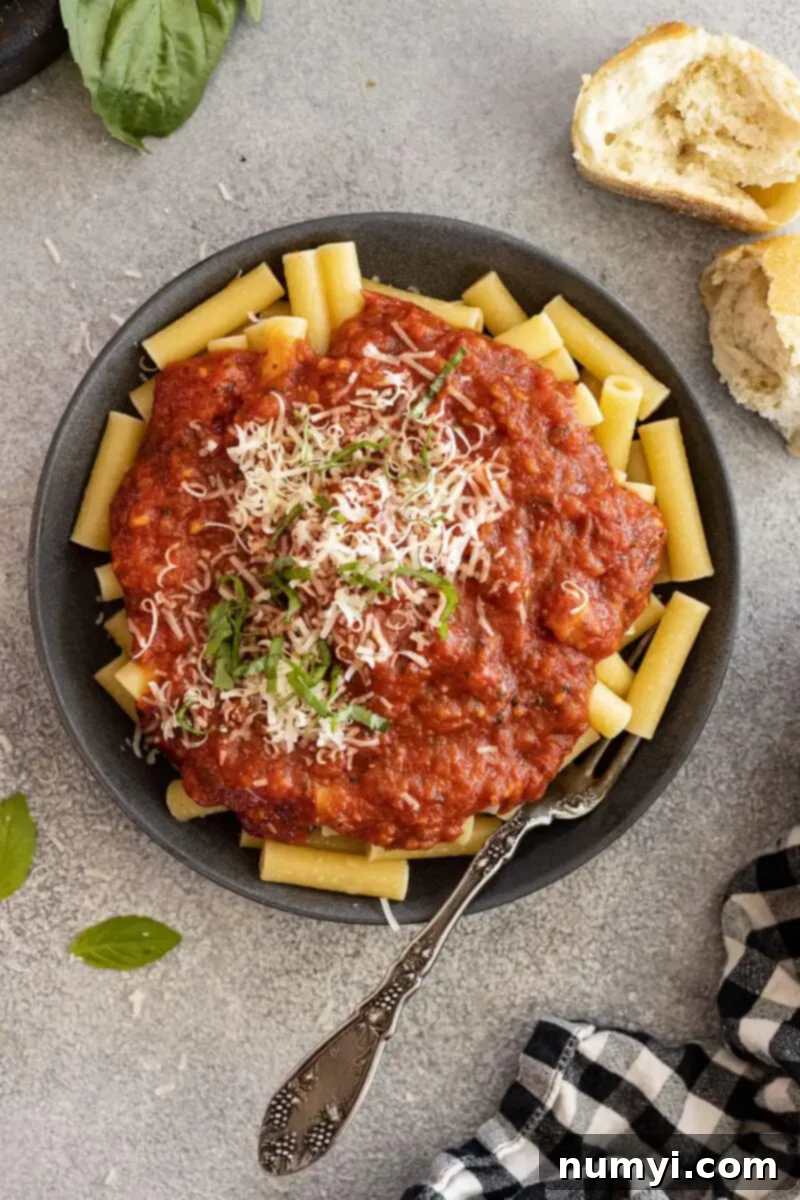
Frequently Asked Questions (FAQs) About Homemade Marinara
Once your delicious homemade marinara sauce has cooled completely, transfer it to an airtight container or jar. Store it in the refrigerator, where it will stay fresh and flavorful for up to 4 days. Always ensure the container is sealed tightly to maintain freshness and prevent odor absorption.
Freezing is an excellent way to preserve marinara sauce for longer periods. Allow the sauce to cool completely before transferring it to freezer-safe containers or heavy-duty freezer bags. For convenience, consider freezing it in individual portions. It can be stored in the freezer for up to 3 months without significant loss of quality. To use, simply thaw overnight in the refrigerator, then gently reheat on the stove.
Absolutely! This marinara sauce is suitable for canning, allowing you to stock your pantry for months. However, when canning, it’s crucial to follow proper and safe canning instructions to prevent spoilage. For home canning, especially with tomato-based sauces, it’s often recommended to add a tiny bit of lemon juice or citric acid to ensure sufficient acidity for safe water bath canning. Always consult reputable resources, such as the Ball canning website, for detailed guidelines and up-to-date safety information for proper preservation.
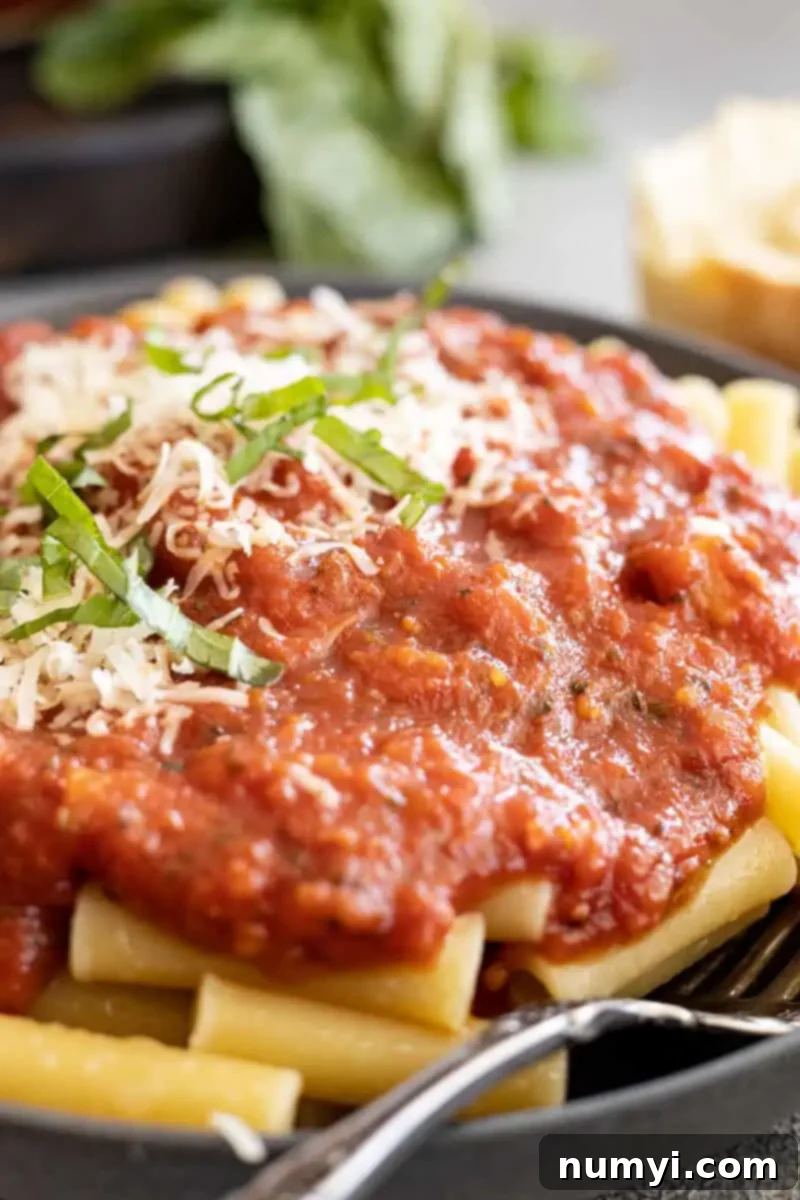
Tips and Suggestions for Your Homemade Marinara
This versatile marinara sauce is just the beginning. Here are some ideas to maximize its use and customize it to your liking:
Delicious Ways You Can Use This Sauce:
- The Simplest Way – On Top of Pasta! Pair it with spaghetti, penne, fettuccine, or any pasta shape you love. Add a sprinkle of fresh Parmesan and basil for a classic, comforting meal.
- Add Meatballs While Simmering: For a hearty and satisfying spaghetti and meatballs, simply add cooked meatballs to the sauce during the last 20-30 minutes of simmering. They’ll absorb the rich flavors of the marinara.
- Use it for Chicken or Eggplant Parmesan: This sauce is the perfect base for these beloved Italian-American classics. Layer it with breaded chicken cutlets or eggplant slices and plenty of cheese, then bake until bubbly and golden.
- Perfect Sauce for Dipping: Serve it warm alongside crispy breadsticks, mozzarella sticks, arancini, or even grilled cheese sandwiches for a delightful appetizer or snack.
- A Versatile Base for Many Recipes: This recipe yields approximately 5 cups of sauce, which is significantly more than most store-bought jars (typically 3 cups). Use the extra in lasagna, baked ziti, as a pizza sauce, for shakshuka, or as the base for a minestrone soup.
- Marinara with Seafood: Toss with sautéed shrimp, scallops, or mussels for a flavorful seafood pasta dish.
Creative Ways to Change Things Up:
- Add Extra Veggies: Beyond carrots and celery, consider finely dicing bell peppers, zucchini, or mushrooms and sautéing them with the initial aromatics for added nutrients and complexity.
- Make it Spicy: For those who love a kick, stir in a pinch or two of crushed red pepper flakes (or more, to taste) when you add the tomato paste. This creates a “fra diavolo” style sauce.
- To Make it a Rose Sauce: After the sauce has finished simmering, stir in ½ to ⅔ cup of heavy cream or half-and-half. This adds a lovely creaminess and a beautiful pink hue, perfect for a richer pasta dish.
- Add a Parmesan Rind: For an incredible depth of umami flavor, add a leftover Parmesan rind to the sauce during simmering. Just remember to remove it before serving. Alternatively, stir in freshly grated Parmesan cheese at the very end.
- Introduce More Herbs: Experiment with other fresh herbs like thyme or marjoram, adding them with the basil for different aromatic notes.
- A Splash of Red Wine: Deglaze the pot with a splash of dry red wine after sautéing the aromatics and tomato paste. Let it reduce by half before adding the tomatoes for a deeper, more sophisticated flavor.
HUNGRY FOR MORE? Don’t miss out on more delicious recipes and cooking tips! Subscribe to my newsletter and follow along on Pinterest, Facebook, and Instagram for all my latest updates!
Homemade Marinara Sauce
This homemade marinara sauce is super easy to make! With just a few staple ingredients and a little simmering on the stove, you can have a healthy, fresh, and flavorful homemade sauce. Plus, you can add a few extra veggies for more flavor and nutrition if you like!
5
cups
Malinda Linnebur
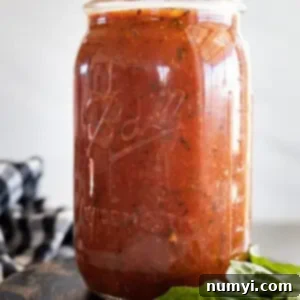
Save Recipe
Saved!
10
minutes
30
minutes
40
minutes
Prevent your screen from going dark
Ingredients
-
½
small
onion -
4
large
cloves garlic -
1
small
carrot, optional -
1
small
celery stalk, optional -
2
tablespoons
olive oil -
1
(6 oz) (170g)
can tomato paste -
1
(28 oz) (793g)
can crushed tomatoes -
1
(14.5 oz) (411g)
diced tomatoes -
1
large
sprig fresh basil -
1
teaspoon
dried oregano
Instructions
-
Finely chop all the vegetables (onion, garlic, and optional carrot and celery) or process them in a food processor to your desired consistency. Heat the olive oil in a large pot over medium heat, then add the chopped vegetables. Cook for 2-3 minutes, stirring occasionally, until softened and fragrant.
-
Stir in the tomato paste and cook for another 1-2 minutes, stirring constantly, until no lumps remain and the color deepens. Then, add the crushed tomatoes, diced tomatoes, dried oregano, and the whole sprig of fresh basil to the pot.
-
Bring the sauce to a gentle simmer, then reduce the heat to low and simmer uncovered for at least 20 minutes, stirring occasionally. The longer it simmers, the more the flavors will develop and the sauce will thicken. Before serving, remove the basil sprig and taste for salt and pepper, adjusting as needed. Serve hot as desired.
Notes
- The carrot and celery are not traditionally added to classic marinara sauce, but I include them for an extra layer of flavor and added nutrition. You can certainly leave them out if you prefer a more traditional marinara.
Nutrition
Serving:
1
cup
|
Calories:
61
kcal
|
Carbohydrates:
3
g
|
Protein:
0.4
g
|
Fat:
6
g
|
Saturated Fat:
1
g
|
Polyunsaturated Fat:
1
g
|
Monounsaturated Fat:
4
g
|
Sodium:
11
mg
|
Potassium:
62
mg
|
Fiber:
1
g
|
Sugar:
1
g
|
Vitamin A:
1685
IU
|
Vitamin C:
2
mg
|
Calcium:
16
mg
|
Iron:
0.3
mg
Did you make this?
Let me know by sharing a picture and tagging @countryside_cravings on Instagram
